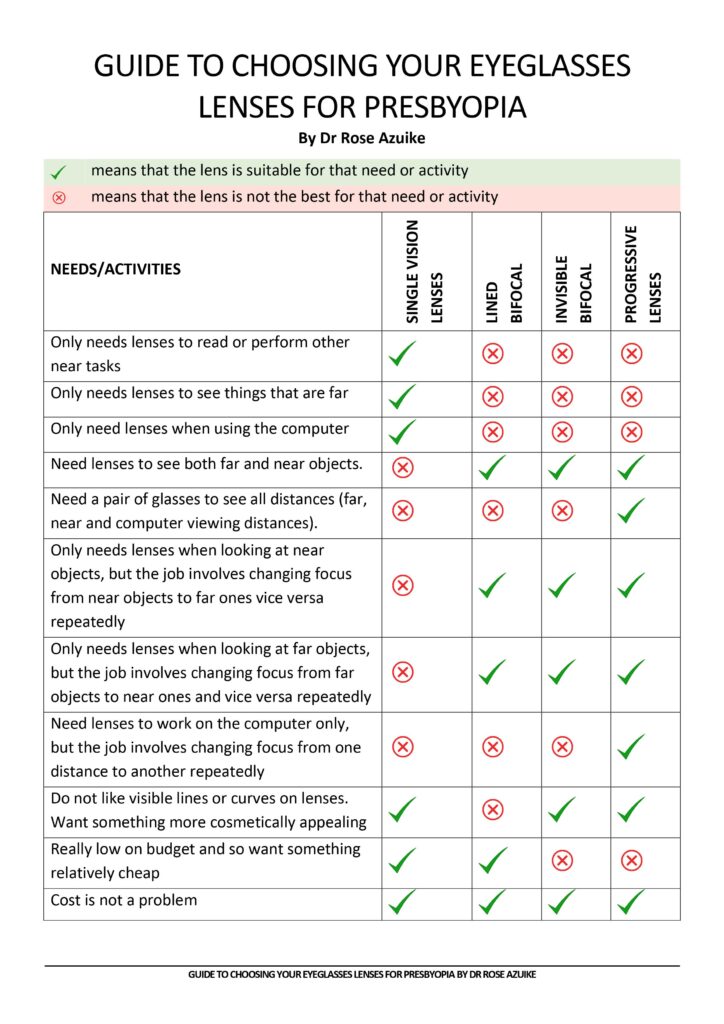Recommending the most suitable eyeglass lenses to people with age-related difficulties with seeing small prints (presbyopia) is a major part of my job. I have seen the good, the bad and the ugly concerning these lenses. In this article, I discuss the different types I have recommended, their pros and cons, based on my knowledge and experience with patients.
Eyeglasses for presbyopia are glasses with lenses designed to improve near vision in people who have lost the ability to see small prints due to normal age-related changes in the eyes.
There are different types of eyeglasses lenses for presbyopia, but, I will focus only on the ones I have prescribed to patients and gotten feedback. They include
- Reading glasses
- Fused bifocals
- Invisible bifocals
- Progressive lenses (also known as varifocals or multifocal lenses)
#1. READING GLASSES
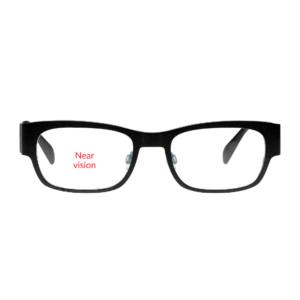 These are eyeglasses fitted with single vision lenses that improve near vision only. They have only one power and are worn to read or perform other near tasks. For this reason, the glasses are only suitable for people who;
These are eyeglasses fitted with single vision lenses that improve near vision only. They have only one power and are worn to read or perform other near tasks. For this reason, the glasses are only suitable for people who;
- Have a ‘perfect’ 20/20 vision and do not need vision correction for distance.
- Intend to wear their glasses only while performing near work.
- Do not mind removing their glasses or looking above them to view objects at a far distance when necessary.
- Do jobs that do not involve changing focus from one distance to another repeatedly.
PROS
- They are readily available and can be bought over the counter in pharmacies and eyeglass shops.
- They are the cheapest type of glasses for presbyopia.
CONS
- They cause blurry distance vision when you look at distant objects through them. So, they are not the best for jobs that require changing focus from one distance to another repeatedly.
- Since the glasses have only one power, they are not the best for people who need far and near vision correction. This means that they are not the best for presbyopic patients that also have a refractive error (like hyperopia or astigmatism).
#2. FUSED BIFOCALS
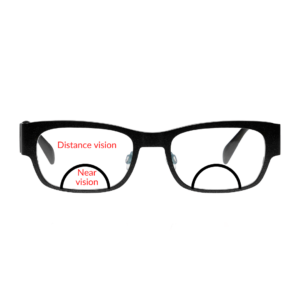 Fused bifocals are lenses with two parts, upper and lower (each with its power), fused into one lens. The upper part of the lens is large and is for viewing things at a far distance, while the lower part is small and for viewing nearby objects. A visible curve known as the segment separates the two parts of the lens.
Fused bifocals are lenses with two parts, upper and lower (each with its power), fused into one lens. The upper part of the lens is large and is for viewing things at a far distance, while the lower part is small and for viewing nearby objects. A visible curve known as the segment separates the two parts of the lens.
So, generally, with fused bifocals, presbyopic patients can see things far away and nearby.
PROS
- They are suitable for many presbyopic patients because they allow people to see things far away and nearby without taking off their glasses.
- Although they often cost more than reading glasses, they are much cheaper than invisible bifocals and progressive lenses.
CONS
- It can be uncomfortable working with them for long hours on the computer. This is because computers are positioned at an intermediate distance (that is, the distance between near and far), and bifocals are not optimized for viewing objects at that distance.
- It takes first-timers some time to get used to the lenses as they learn to look through the two parts. It could take a few hours to days to learn how to look through the lens. A very small percentage of people, especially those who don’t have the patience to learn how to use the lenses, never get used to them.
- They are less cosmetically appealing because of the visible curve separating the two parts of the lens.
- They are no more available in some prescriptions, as some optical labs are gradually phasing them out.
#3. INVISIBLE BIFOCALS
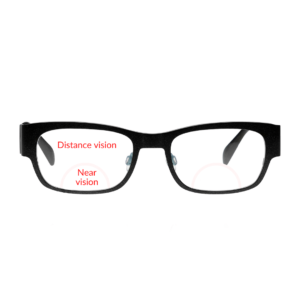 Invisible bifocals are a more modern type of bifocals. They function just like fused bifocals, but, the segment separating the two parts of the lens is not visible.
Invisible bifocals are a more modern type of bifocals. They function just like fused bifocals, but, the segment separating the two parts of the lens is not visible.
PROS
- They are suitable for many presbyopic patients because they allow people to see things at far and near distances without taking off their glasses.
- They are more cosmetically appealing and more readily available than fused bifocals.
CONS
- Just like fused bifocals, working with them for long hours on the computer can e uncomfortable.
- It also takes first-timers some time to get used to the lenses as they learn how to look through the two parts.
#4. PROGRESSIVE LENSES
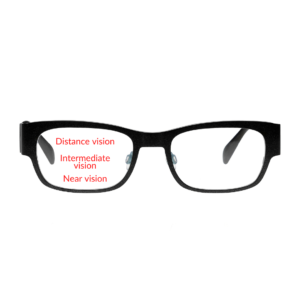 Progressive lenses are lenses that have multiple powers in one lens. They are also known as multifocal lenses or varifocal lenses. No lines are separating the various areas of the lens. So, they look like single vision lenses, but unlike single vision lenses, they have multiple powers in a lens.
Progressive lenses are lenses that have multiple powers in one lens. They are also known as multifocal lenses or varifocal lenses. No lines are separating the various areas of the lens. So, they look like single vision lenses, but unlike single vision lenses, they have multiple powers in a lens.
With a progressive lens, you can practically see things at all distances with the three major viewing areas namely:
- Upper – For viewing things at a far, like other cars while driving
- Middle – For viewing things at an intermediate distance, like the desktop computer
- Lower – For viewing things nearby like the book you are reading or writing on
PROS
- They are suitable for most presbyopic patients because they allow people to see things at all distances without taking off their glasses.
- They are more cosmetically appealing than bifocals.
- You can wear only one pair of glasses for everything.
CONS
- They cost more than all the other types of glasses for presbyopia.
- It takes first-timers some time to get used to the lenses as people learn how to look through the various area. It could take a few days to weeks. A very small percentage of people especially those who don’t have the patience to learn how to use the lenses, never get used to them.
WHICH OF THE LENSES ARE THE BEST?
Generally, none is the best. A particular type of lens may be the best for one person and the worst for another. Therefore, the best lens type depends on individual needs and preferences.
However, these are my general recommendations:
- If your daily activities involve changing focus from one distance to another repeatedly, you are better off with a pair of glasses that allows you to do that comfortably. This could be a pair of bifocals or progressive lenses depending on your daily activities.
- If you need glasses to only read at a particular time every day and are fine without glasses for the rest of the day, a pair of reading glasses is enough for you.
- If the best type of lens for you is a bifocal and funds for your lenses are not a problem, you are better off with an invisible bifocal.
That stated, note that the best person to guide you with choosing your lenses is your eye care provider. S/he has your history, knows your needs and preferences and can make personalized recommendations. But, if you want to decide on your own or have an idea of what would be most suitable for you, the table below would be helpful.
